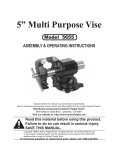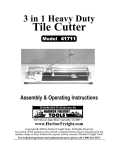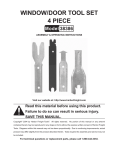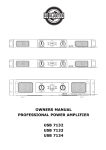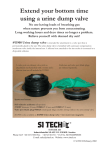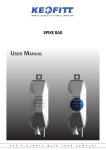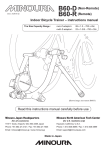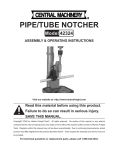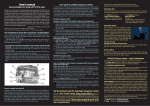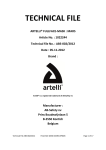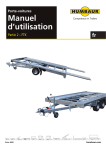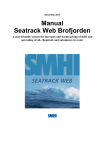Download USER'S MANUAL ”Quick Glove Rings” Art. No.60220
Transcript
USER’S MANUAL ”Quick Glove Rings” Art. No.60220 A Part list: B C C1 C2 #60209 #60210 #60211 #60212 #80185 RELEASE RING CONNECTING RING SPANNER RING BLACK for thick gloves SPANNER RING BLUE for thin gloves O-RINGS (C2) (C) (B) (B) (C1) 2 PCS 2 PCS 2 PCS 2 PCS 2 PCS Description A waterproof connection of gloves to the suit sleeves is obtained by combining almost any dry glove assembled into the ”Quick Glove Rings” with either of these two systems, also designed by SI TECH: ♦ ”Quick Cuff” (art. # 60900/60910) cuff seal exchange system ♦ ”Quick Clamp” (art. # 60930) docking for fixed seals An O-ring on the connecting ring seals against the inner diameter of the Quick Cuff stiff ring (#60200) or the Quick Clamp docking ring (#60931). The O-ring must not be lubricated in order to achieve maximum friction. The glove is fixed in the connecting ring by means of an inner spanner ring, keeping the glove in place and sealing. The Quick Glove Rings (#60220) are delivered with spanner rings in two different diameters to provide attachment regardless of glove material thickness. Any type of glove can be used as long as they have at least one smooth external surface which allows a watertight seal against the Quick Glove Rings. Doffing can be done without assistance, using only one hand. The release ring is turned a full turn until the connecting ring separates from the Quick Cuff stiff ring (#60200) or the Quick Clamp docking ring (#60931). Assembly of glove rings and gloves Before entering the water, make several tries to attach gloves into the quick glove rings and fit the ring system on to the Quick Cuff stiff ring (#60200) or the Quick Clamp docking ring (#60931) In order to get aquainted with the function. Initially some extra force may be needed, but not excessive. 1. Insert the spanner ring #60211 (black) or #60212 (blue) in the glove shaft. Use the spanner ring that is most snug-fitting. (Spanner rings may be wrapped with flexiblrtape to obtain proper thightness between the glove shaft and the connecting ring.) When using a glove with separate liner, remove the liner and use the blue ring. (The liner may be fixated into the connecting ring in combination with the glove, preferably by using the black ring). The arm length can be adjusted depending on how far down in the glove the spanner ring is located. 2. Fold excess glove sleeve from the outside over the spanner ring to the inside. (Latex gloves may be folded the reverse way, outwards when placed inside the spanner ring.) 3. Insert the spanner ring and the glove into the connecting ring. Slide the spanner ring all the way into the recess by holding the smallest end of the connecting ring in both palms while pressing down with the finger tips on the spanner ring that is inside the glove shaft. It is important to stretch the glove shaft and press evenly to avoid wrinkles that may cause leakage. Some force may be needed to make sure that the spanner ring is pressed all the way into the recess. If not properly protected by the connecting ring the glove will be exposed and leakage problems may occur. (For latex glovestalcum powder can be used to reduce the friction.) 4. The release ring (C2) must be turned to its distinct stop before attaching the connecting ring into ”Quick Cuff” or ”Quick clamp”. Negligence to do this before the donning may obstruct the doffing. N.B. The release ring is a release aid, not to be used for locking, nor for attaching. The O-ring (C1) on the connecting ring seals against the Quick Cuff stiff ring (#60200) or the Quick Clamp docking ring (#60931). Make sure that the O-ring is free from lubricant and dirt. 5. Insert the connecting ring (C) into the Quick Cuff (with inserted latex cuff) or the Quick Clamp. If using one hand, use the lower part of the palm and the fingertips to press the Quick Glove connecting ring into the Quick Cuff or the Quick Clamp. A few squeezing hand grips around both rings will be needed to make sure that the two rings are completely joined. If any lubricating is required, only use saliva or water. N.B. Do not lubricate O-rings with any grease as this will reduce the friction keeping the Quick Glove Rings in positon and it may cause sand and dirt to collect. 6. Doffing the Quick Glove Ring is initiated by turning the release ring (with the knobs) a full turn. This will force the connecting ring away from the Quick Cuff or the Quick Clamp. To separate the rings, close the hand and bend the fist forwards while pulling the suit sleeve. Maintenance Detach the gloves after diving and rinse all the parts thoroughly in fresh water. Make sure that all sand and dirt is removed. Wipe all parts with a clean dry cloth before the re-assembly. N.B. O-rings must be changed if leaking. It’s a good idea to keep a spare. It is particularly important to ensure that the O-ring and the groove in the connecting ring (#60210) are clean if the O-ring has been removed. Pressure equalization of the glove Creating an air channel for equalization of the pressure in the glove is essential when diving deeper than 15-20 meter: A) A self adhesive band aid under the latex seal. Cut it in lengths of 50-80 mm (2-3”) with the desinfection surface covering the under side of the wrist, making a channel. The latex seal may be trimmed for better comfort. B) A thick thread, or a flexible surgical tube (150 mm or 6 inch long) between skin and latex seal. C) Wear the liner under the cuff seal. Correct assembly of Quick Glove Rings and Quick Cuff QUICK GLOVE RINGS release ring connecting ring glove shaft spanner ring QUICK CUFF wrist ring latex seal stiff ring USER’S MANUAL ”Quick Clamp” Art. No. 60930 #60931 DOCKING RING 2 PCS #60211 SPANNER RING BLACK 2 PCS #60212 SPANNER RING BLUE 2 PCS 1. Slide the spanner rings (#60211 for heavy latex seals or #60212 for thin latex) all the way down the suit sleeve into the cuff seal. Use the spanner ring that is most snug-fitting. (Spanner rings may be wrapped with flexible tape to obtain a snug fit between the glove shaft and the connecting ring.) The ring must go beyond the end of the suit sleeve material and the reinforcements and make direct contact with a single layer of latex. Fixate the spanner ring by folding the latex seal inwards. The ring must be firmly and evenly placed. 2. Slide the docking ring over the outside of the latex seal with the larger flange facing outwards. Slide all the way up until the spanner ring meets the recess in the docking ring (#60931). 3. Hold the docking ring in both hands with the larger flange resting in both palms. Force the spanner ring further in, using thumbs or finger tips, little by little, while turning the docking ring. Talcum powder may be used to reduce the friction. Make sure that the spanner ring is inserted evenly into the docking ring, all the way up to the ridgeline on the inside of the docking ring, if possible. Convince yourself of proper fitting and test the Glove Ring connection before diving. 4. To remove, place the sleeve opening towards yourself and insert both thumbs through the latex seal to the inside of the docking ring. Push the spanner ring outwards segment by segment using both thumbs. Maintenance Don’t use any form of lubrication and always rinse with fresh water after each dive to remove sand and prevent salt crystals to form. Detach in order to save the latex during storage. Avoid high temperatures when latex cuff seals are installed. USER’S MANUAL ”Quick Cuff” Art. No. 60910 C B A #60420 WRIST RING, polyurethane (A) 2 PCS #60200 STIFF RING for wrist ring, polyblend (B) 2 PCS #61100 LATEX SEALS (Size M), natural rubber (C) 2 PCS #61355 PU TAPE, heat activated PU tape 0,7 M (Other cuff models and diffrent sizes can be ordered from your local supplier or directly from SI TECH) Part list: Attachment of the latex seal into the ”Quick Cuff” 1. Place the latex cuff seal (C) inside the stiff ring and fold it over the locking groove of the stiff ring (B). Let the latex cuff seal cover the stiff ring by approximately 1,5 cm. For easy assembly, the latex cuff may be secured with with flexible tape before insertion into the wrist ring. N.B. No tape over the locking groove. 2. Insert the assembly into the wrist ring(A). Force the stiff ring with both palms, pressing segment by segment until it’s finally ”clicks” in place. No excessive latex should be visible outside the stiff ring. Counter hold the seal shaft to prevent the seal from sliding. Several tries may be needed before you get the proper technique. (See website www.sitech.se for photos) These are suggestions only. Whatever method chosen, convice yourself that the latex is properly treated. Excessive latex can be trimmed. Make a leakage test before diving. In stead of seals, gloves may be semi permanently installed. They must however have one smooth side to seal against the internal wall of the wrist ring (#60220). Put the stiff ring (#60200) inside the glove and fold the glove shaft into or over the stiff ring. Depending on glove material thickness and if a combination of cuffs and gloves is desired, it may be possible to insert such an assembly. It will seal and stay in place anyway. Maintenance After each dive detach the stiff ring, cuff and/or glove in order to rinse latex and PU wrist ring from salt or dirt and to relax the wrist ring from stress settings, which can create leakage. Wash latex parts that are exposed to sweat in luke warm soap water. Avoid heat and sunlight expoure of the PU wrist ring. Heat and storage with inserted latex seal and stiff ring may cause the material to expand, which may cause leakage. If so, heat the wrist ring inernally with a hair dryer and wrap a strong rubber band around it to make it shrink while cooling. USER’S MANUAL ”Quick Cuff Do it yourself kit” Art. No. 60900 Instructions regarding attachment of the latex seal and maintenance, see #60910 above. Parts are as #60910 above, plus brush, sand paper and, if allowed by local transport regulations, PU glue and hardener. Preparations before gluing Measure and adjust the sleeve length wearing the suit and normal underwear garment. The installation may make the sleeve longer. When attached to the sleeve, the outer end of the wrist ring should not exceed the wrist when stretching the arms forward. As most sleeves are tapering, ensure that the sleeve circumference is matching the wrist ring before lenght adjustment. (If the sleeve becomes too short, a neoprene extension may be used.) Buff all non fabric surfaces that are supposed to be glued. Make sure to have good ventilation when working with glue. Wash, with Acetone or Toluene (unless otherwise is stated by the glue manufacturer), all surfaces that will be glued, prior to applying the first coat of glue. The PU material will be more receptive to the glue if swollen with solvent or preheated. Preheat the wristring with a hot airgun (60-80°) prior to applying the first coat of glue. Important issues about glue and gluing Polyurethane (PU) based glue is recommended for the attachment of the PU wrist ring (#60420) to the suit. Neoprene glue is not recommended since it may permanently swollen the material. To achieve the best bonding and saturation of all materials, including natural rubber, the first (and possibly second) coat of PU glue must be thinned and hardener added. PU glue can normally be thinned with Acetone or Toluene. Follow the glue manufacturer recommends if otherwise than above. Mixed glue has a limited pot life. Do not mix too much each time. Buff all surfaces that are supposed to be glued. Wipe clean with solvent recommended by glue manufacturer. Apply 2-3 thin coats of glue (every coat mixed with hardener as omitted hardener may weaken the seams) on all surfaces making sure thatall seams are well covered. Allow each coat to dry well. When using SI TECH or other heat activated PU glue, allow the two surfaces to dry well enough so that, if mismatched during the attachment, they can be separated with ease. An inside support that fills the sleeve end is a valuable help when fitting the glued surfaces together. Use a hot air gun to melt the glue until good bonding is achieved. Heat one segment at a time in all four corners. Apply pressure and work on the remaining surfacces. Make sure that the glue is thoroughly hot and bonding well. Apply pressure to all glued surfaces and force remaining air in seams and air pockets towards the edges. Allow to cool under pressure or tension. Heat activated PU tape is supplied with the Quick Cuff sets #60900 and #60910. Apply glue on the suit and PU wrist ring #60420, but not on the tape. Let dry thoroughly. Heat the tape and glue on sleeve and wrist ring, 5 cm at a time with, a hot air gun or hair dryer and stretch the tape gently when applying. Apply pressure to all glued surfaces and force remaining air in seams and air pockets towards the edges. Allow to cool under pressure or tension. These are recommendations only. Follow glue manufacturers instructions for proper bonding. Leakage test before use. Gluing instructions for wrist ring art. # 60420 Study previous chapters about glue and gluing. Depending on the circumference, the wrist ring can be cemented either on the inside or on the outside of the suit sleeve. There are three alternatives where to put the wrist ring: On the inside of a medium circumferenced sleeve On the outside of a small circumferenced sleeve EXPANDED NEOPRENE: On a sleeve with large circumference, the large part of the wrist ring is glued into the suit. glue Medium circumference sleeve: On neoprene suits, cut the edge perpendicular and apply glue on exposed neoprene and the perpendicular surface of the wrist ring. Be extra careful to even out all sharp edges in joints and seams on the suit with sandpaper, not with glue. glue If using heat activated glue, insert the wrist ring into the sleeve when the last layer of glue is SHELL SUIT: dry. Place the glued surfaces together. Heat activate the glue, apply pressure and let dry. tape Reinforce the seams with heat activated tape to seal the edge. Apply pressure to all glued surfaces and allow to dry. On shell suits the sleeve is attached on the narrow part of the wrist ring. Allow at least 5 mm for sealing tape to overlap the sleeve edge. tape (Chamfer, glue and fold neoprene) tape Large circumference sleeve: Follow the procedures above (medium circumference), but apply glue on the outside of the large diameter part of the wrist ring. Cut away the small part of the wrist ring. (Leaving 5 mm will be helpful when detaching the stiff ring, #60200). Buff the outside thoroughly. Wash with solvent. Allow 5 mm for the tape to overlap. A neoprene extension can be used to decrease the sleeve circumference. These are recommendations only. Convince yourself of proper bonding. Leakage test before diving. ® Special Diving Products and Innovation TECHnology AB. Industrihotellet SE-453 91 LYSEKIL Sweden Phone: Int’l +46 523 15010 Fax +46 523 611511 E-mail: [email protected] Website: www.sitech.se cut Art. #60992 USER’S MANUAL Quick Glove Ring System, 2:nd edition, printed Nov. 2000 Small circumference sleeve: Follow the procedures above (medium circumference), but apply glue on the inside of the wrist ring. Put the wrist ring on the outside of the sleeve. Tape the junction between the rear edge of the wrist ring and the sleeve. (If possible, turn the wrist ring inside out and seal with tape on the inside of the suit.) On neoprene suits, chamfer the sleeve edge, apply glue on the exposed neoprene and fold the chamfered egde to make the neoprene seal agianst the wrist ring..




